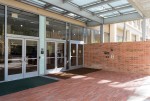Neil Garg eats breakfast with his students before teaching a Fiat Lux freshman seminar on the Hill as a way to engage with students outside of the classroom.
Garg, an organic chemistry professor, lives on the Hill as a Faculty-in-Residence.
The FIR program allows 20 professors to reside on the Hill with their families and pets. Its mission is to foster both formal and informal interactions between residents and faculty through educational programming, classes, individual and small group advising, and casual association, according to a presentation given at an FIR orientation this fall.
Charlene Villaseñor Black, a professor of art history and Chicana/o studies, said she joined the FIR program because she wanted to interact with students more.
“I was motivated by a desire to prioritize student contact at a public research university. The hallmark of private liberal arts colleges is faculty contact,” said Villaseñor Black. “So I was hoping to offer that at a public research university.”
Before becoming an FIR, Villaseñor Black said she judged students based on their grades in her classes. She said she has learned that students’ grades are not representative of their abilities, because students getting B’s in her classes are often involved in activities outside of the classroom.
Villaseñor Black said she has taken students in her assigned building on trips to museums, helped organize academic programming and held events on the Hill. Villaseñor Black’s favorite event that she helps organize is a Día de Los Muertos event, which was first held in 2010 with around 100 people in attendance, and grew to accommodate nearly 700 students last October.
“Last year they took it outside, which was a huge improvement,” Villaseñor Black said. “There was homemade Mexican hot chocolate, mariachis from the music school played, baile folklorico dancers came, students made altars. … My favorite part was probably the spontaneous dancing that broke out in Sproul Turnaround.”
Michael Rodriguez, a professor and vice chair in the department of family medicine at David Geffen School of Medicine, said he is able to guide pre-medical and pre-health students with their career paths as an FIR. He has taught students about the importance of humility and maintaining a positive attitude when interacting with patients, something he said he thinks professors do not emphasize in their undergraduate classes.
“One of the things that’s so exciting for me is to be able to give, and I know that many students come here and have a vision of wanting to be a physician,” said Rodriguez. “I want to try to find the different ways that students can engage with us and our projects, and help it be meaningful to them and their own passions.”
Undergraduate students on the Hill differ from the graduate students Rodriguez teaches because they are less certain about what they want to do, Rodriguez said.
“Graduate students have more experience, they’ve been engaged in more projects, they have more sense of what they want to do,” Rodriguez said. “The undergraduates are like an open book.”
On the Hill, Rodriguez said he tries to emphasize community and connectedness among students and faculty. One way he engages students is by encouraging them to check in with or greet fellow students if they are sitting alone in a dining hall.
“Even though there are people everywhere, they are all strangers. So I tell them, ‘Let’s get together, let’s connect,’” Rodriguez said. “It gives me lots of pleasure to know that I made a difference in the life of one student, and if it makes a difference for one student, that’s good enough.”
Rodriguez said he decided to become an FIR and move on campus with his family partially because he enjoyed connecting and engaging with younger students as a professor in the UCLA Cluster Program. The cluster program offers yearlong classes available to first-year students to learn about an interdisciplinary topic from the perspectives of different subjects.
“I met somebody who was a Faculty-in-Residence and I said ‘Wow, well I’m already engaged with them, so this would be a great way to take the next step and be immersed in the culture and be part of the community,’” said Rodriguez.
Unlike Villaseñor Black and Rodriguez, Garg had experience working with Residential Life as a residential adviser when he was an undergraduate student at New York University. He said, however, that a key difference between RAs and FIRs is that FIRs are not on the Hill to discipline students or enforce rules the way RAs are, but rather to serve as informal mentors and advisers.
“You live here on campus and you interact with students, not in a disciplinary way or anything like that, other people deal with that, but really just to be a positive resource for students and then hopefully let them see that we’re somewhat normal,” Garg said.
Garg said the focus and goal of Residential Life is student support.
“The group of Faculty-in-Residence, we do it because we enjoy interacting with students,” Garg said. “They should feel free, even if it’s in a dining hall, that it’s OK to go up to a Faculty-in-Residence.”
